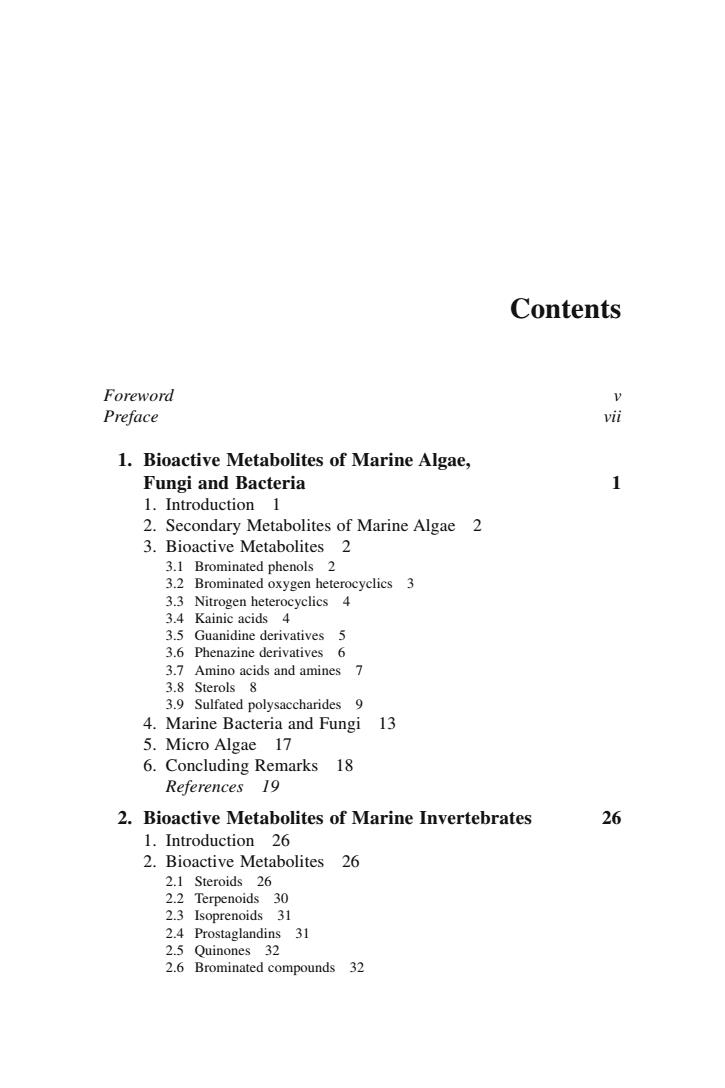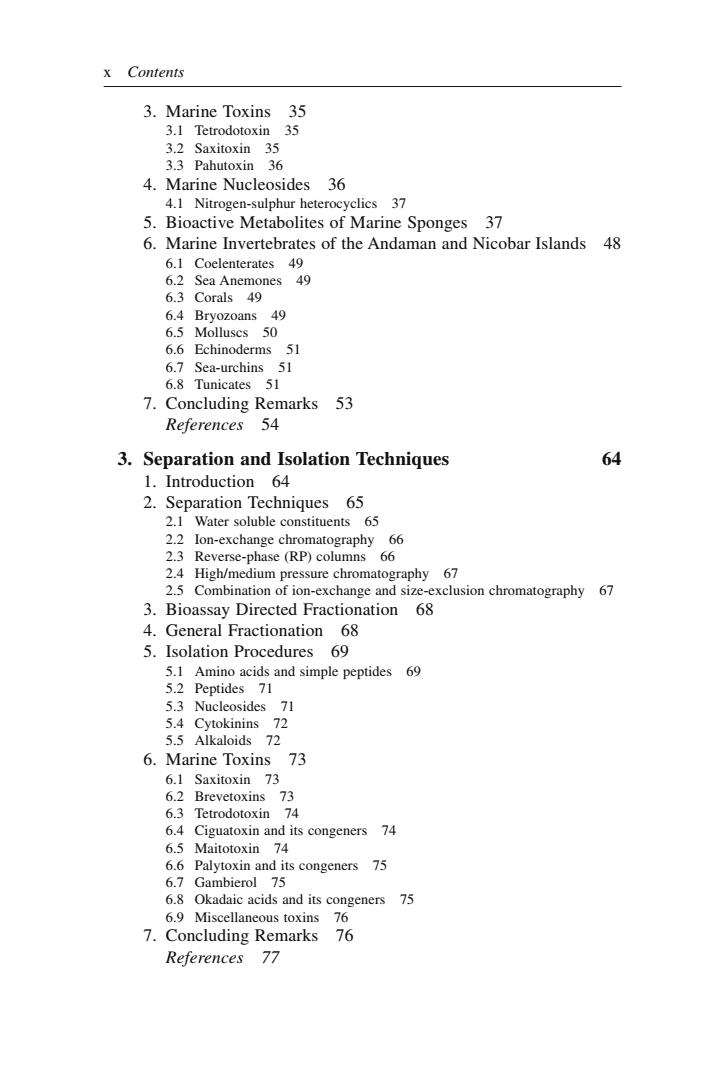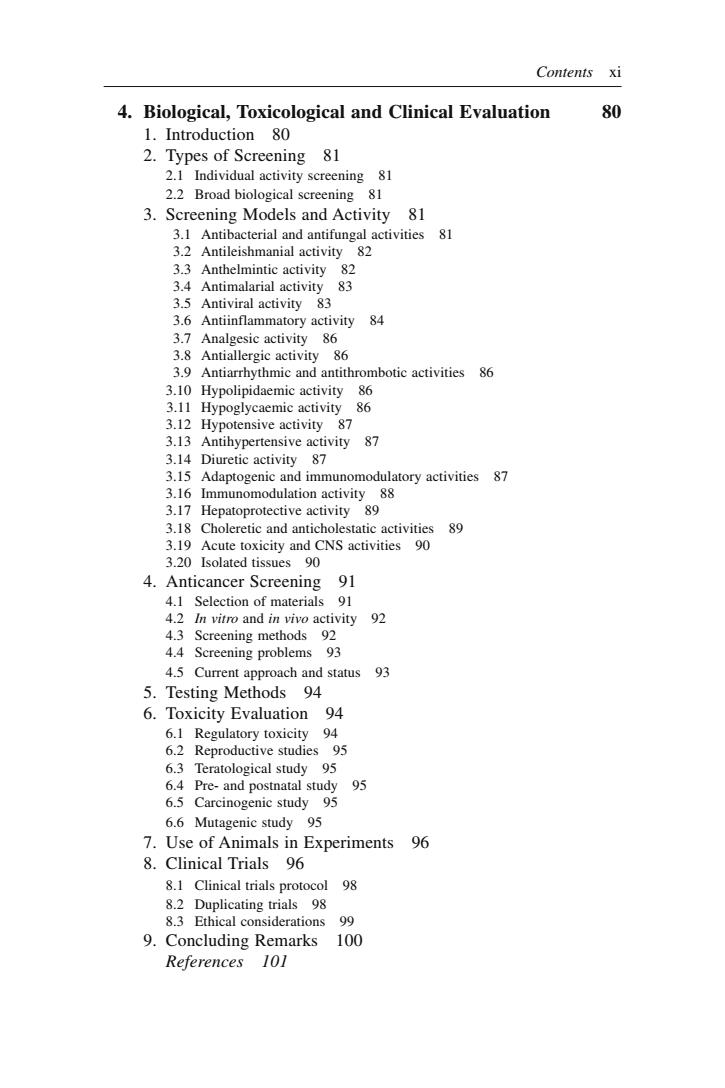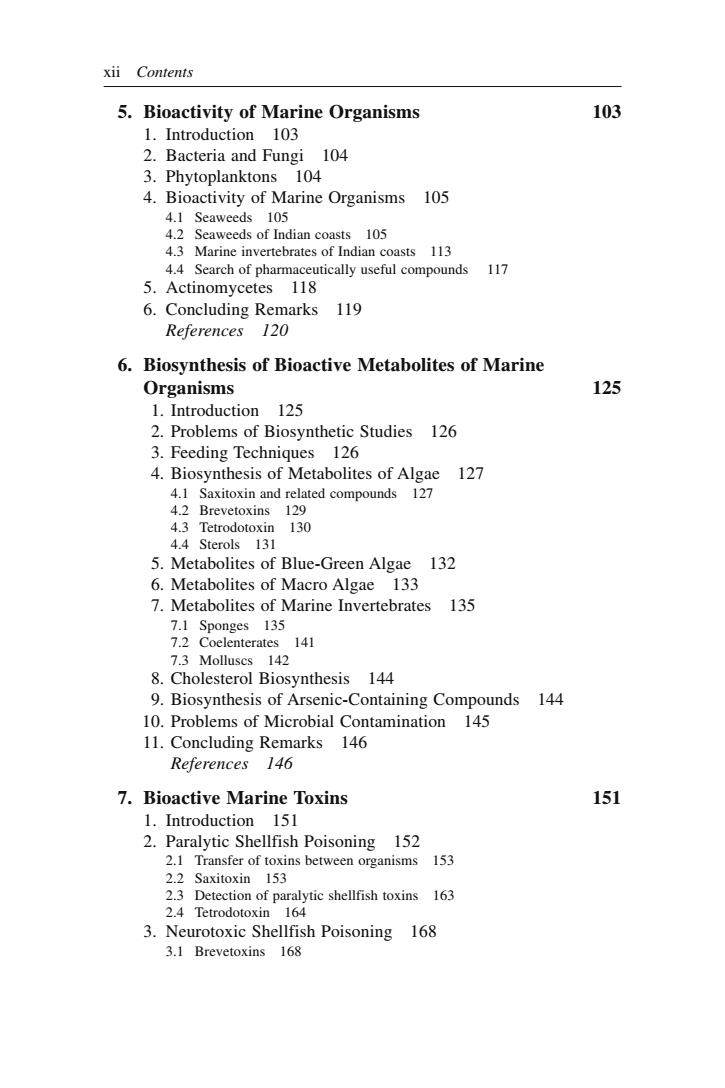
Contents Foreword Preface 1.Bioactive Metabolites of Marine Algae, Fungi and bacteria 1 Introduction 1 2.Secondary Metabolites of Marine Algae 2 3.2 Brominated oxygen heterocyclics 3 3.3 Nitrogen heterocyclics 4 atives 5 3.6 Phenazine derivatives6 3.Sulfated polysaccharides9 4.Marine Bacteria and Fungi 13 5.Micro Algae 17 6.Concluding Remarks 18 References 10 2.Bioactive Metabolites of Marine Invertebrates 26 1.Introduction 26 2.Bioactive Metabolites 26 2.1 Steroids 26 2.4 Prostaglandins 31
Contents Foreword v Preface vii 1. Bioactive Metabolites of Marine Algae, Fungi and Bacteria 1 1. Introduction 1 2. Secondary Metabolites of Marine Algae 2 3. Bioactive Metabolites 2 3.1 Brominated phenols 2 3.2 Brominated oxygen heterocyclics 3 3.3 Nitrogen heterocyclics 4 3.4 Kainic acids 4 3.5 Guanidine derivatives 5 3.6 Phenazine derivatives 6 3.7 Amino acids and amines 7 3.8 Sterols 8 3.9 Sulfated polysaccharides 9 4. Marine Bacteria and Fungi 13 5. Micro Algae 17 6. Concluding Remarks 18 References 19 2. Bioactive Metabolites of Marine Invertebrates 26 1. Introduction 26 2. Bioactive Metabolites 26 2.1 Steroids 26 2.2 Terpenoids 30 2.3 Isoprenoids 31 2.4 Prostaglandins 31 2.5 Quinones 32 2.6 Brominated compounds 32

x Contents 3.Marine Toxins 35 3.1 Tetrodotoxin 35 4.Marine Nucleosides 36 4.1 Nitrogen-sulphur heterocyclics 37 5.Bioactive Metabolites of Marine Sponges 37 6.Marine Invertebrates of the Andaman and Nicobar Islands 48 6.1 Coelenterates 49 rals 66 Echinod 7.Concluding Remarks 53 References 54 3.Separation and Isolation Techniques 64 1.Introduction 64 2.Separation Techniques 65 2.1 Water soluble constituents 65 2 on-exchange ch phy 67 2.5 Combination of ion-exchange and size exclusion chromatography 67 3.Bioassay Directed Fractionation 68 4.General Fractionation 68 5.Isolation Procedures 69 71 5.4 Cytokinins 72 5.5 Alkaloids 6.Marine Toxins 73 nd Is congeners 75 75 Oadaic acids and its 7.Concluding Remarks References 77
x Contents 3. Marine Toxins 35 3.1 Tetrodotoxin 35 3.2 Saxitoxin 35 3.3 Pahutoxin 36 4. Marine Nucleosides 36 4.1 Nitrogen-sulphur heterocyclics 37 5. Bioactive Metabolites of Marine Sponges 37 6. Marine Invertebrates of the Andaman and Nicobar Islands 48 6.1 Coelenterates 49 6.2 Sea Anemones 49 6.3 Corals 49 6.4 Bryozoans 49 6.5 Molluscs 50 6.6 Echinoderms 51 6.7 Sea-urchins 51 6.8 Tunicates 51 7. Concluding Remarks 53 References 54 3. Separation and Isolation Techniques 64 1. Introduction 64 2. Separation Techniques 65 2.1 Water soluble constituents 65 2.2 Ion-exchange chromatography 66 2.3 Reverse-phase (RP) columns 66 2.4 High/medium pressure chromatography 67 2.5 Combination of ion-exchange and size-exclusion chromatography 67 3. Bioassay Directed Fractionation 68 4. General Fractionation 68 5. Isolation Procedures 69 5.1 Amino acids and simple peptides 69 5.2 Peptides 71 5.3 Nucleosides 71 5.4 Cytokinins 72 5.5 Alkaloids 72 6. Marine Toxins 73 6.1 Saxitoxin 73 6.2 Brevetoxins 73 6.3 Tetrodotoxin 74 6.4 Ciguatoxin and its congeners 74 6.5 Maitotoxin 74 6.6 Palytoxin and its congeners 75 6.7 Gambierol 75 6.8 Okadaic acids and its congeners 75 6.9 Miscellaneous toxins 76 7. Concluding Remarks 76 References 77

Contents xi 4.Biological,Toxicological and Clinical Evaluation 80 1.Introduction 80 ning 81 Individual ac ning 8l 2.2 Broad biological screening 81 3.Scr ing Models and Activity 81 站 rial and antifungal activities 81 82 3 5 Antiviral activity 83 3.6 Antiinflammatory activity 84 3.9 Antiarrhythmic and antithrombotic activities 86 86 87 tivity 87 314 Diuretic ac vity 3.16 Immunomodulation activity modulatory activities87 88 3.17 Hepatoprotective activity 89 9 eretic and ar nd CNS 89 3.20 Isolated tissues 90 4. Anticancer Screening 91 91 43 nd 4.4 Screening problems 93 4.5 Current approach and status 93 5.Testing Methods 94 6.Toxicity Evaluation 94 6.1 Regulatory toxicity 94 6.2 Reproductive studies gic 6.5 Carcinogenic study 5 6.6 Mutagenic study 95 7.Use of Animals in Experiments 96 8.Clinical Trials 96 8.1 Clinical trials protocol98 8.2 Duplicating trials 98 8.3 Ethical considerations 99 9.Concluding Remarks 100 References 101
Contents xi 4. Biological, Toxicological and Clinical Evaluation 80 1. Introduction 80 2. Types of Screening 81 2.1 Individual activity screening 81 2.2 Broad biological screening 81 3. Screening Models and Activity 81 3.1 Antibacterial and antifungal activities 81 3.2 Antileishmanial activity 82 3.3 Anthelmintic activity 82 3.4 Antimalarial activity 83 3.5 Antiviral activity 83 3.6 Antiinflammatory activity 84 3.7 Analgesic activity 86 3.8 Antiallergic activity 86 3.9 Antiarrhythmic and antithrombotic activities 86 3.10 Hypolipidaemic activity 86 3.11 Hypoglycaemic activity 86 3.12 Hypotensive activity 87 3.13 Antihypertensive activity 87 3.14 Diuretic activity 87 3.15 Adaptogenic and immunomodulatory activities 87 3.16 Immunomodulation activity 88 3.17 Hepatoprotective activity 89 3.18 Choleretic and anticholestatic activities 89 3.19 Acute toxicity and CNS activities 90 3.20 Isolated tissues 90 4. Anticancer Screening 91 4.1 Selection of materials 91 4.2 In vitro and in vivo activity 92 4.3 Screening methods 92 4.4 Screening problems 93 4.5 Current approach and status 93 5. Testing Methods 94 6. Toxicity Evaluation 94 6.1 Regulatory toxicity 94 6.2 Reproductive studies 95 6.3 Teratological study 95 6.4 Pre- and postnatal study 95 6.5 Carcinogenic study 95 6.6 Mutagenic study 95 7. Use of Animals in Experiments 96 8. Clinical Trials 96 8.1 Clinical trials protocol 98 8.2 Duplicating trials 98 8.3 Ethical considerations 99 9. Concluding Remarks 100 References 101

xii Contents 5.Bioactivity of Marine Organisms 103 1.Introduction 103 2.Bacteria and Fungi 104 lankton 104 105 5. ctimomycre17 Actinomycetes 6.Concluding Remarks 119 References 120 6.Biosynthesis of Bioactive Metabolites of Marine Organisms 125 1.Introduction 125 2.Problems of Biosynthetic Studies 126 3.Feeding Techniques 126 4.Biosynthesis of Metabolites of Algae 127 4.1 Saxitoxin and related compounds 127 rols 131 5.Metabolites of Blue-Green Algae 132 6.Metabolites of Macro Algae 133 7.Metabolites of Marine Invertebrates 135 135 141 144 9.Biosynthesis of Arsenic-Containing Compounds 144 10.Problems of Microbial Contamination 145 11.Concluding Remarks 146 References 146 7.Bioactive Marine Toxins 151 1.Introduction 151 2.Paralytic Shellfish Poisoning 152 2.1 Transfer of toxins between organisms 153 3.Neurotoxic Shellfish Poisoning 168 3.1 Brevetoxins 168
xii Contents 5. Bioactivity of Marine Organisms 103 1. Introduction 103 2. Bacteria and Fungi 104 3. Phytoplanktons 104 4. Bioactivity of Marine Organisms 105 4.1 Seaweeds 105 4.2 Seaweeds of Indian coasts 105 4.3 Marine invertebrates of Indian coasts 113 4.4 Search of pharmaceutically useful compounds 117 5. Actinomycetes 118 6. Concluding Remarks 119 References 120 6. Biosynthesis of Bioactive Metabolites of Marine Organisms 125 1. Introduction 125 2. Problems of Biosynthetic Studies 126 3. Feeding Techniques 126 4. Biosynthesis of Metabolites of Algae 127 4.1 Saxitoxin and related compounds 127 4.2 Brevetoxins 129 4.3 Tetrodotoxin 130 4.4 Sterols 131 5. Metabolites of Blue-Green Algae 132 6. Metabolites of Macro Algae 133 7. Metabolites of Marine Invertebrates 135 7.1 Sponges 135 7.2 Coelenterates 141 7.3 Molluscs 142 8. Cholesterol Biosynthesis 144 9. Biosynthesis of Arsenic-Containing Compounds 144 10. Problems of Microbial Contamination 145 11. Concluding Remarks 146 References 146 7. Bioactive Marine Toxins 151 1. Introduction 151 2. Paralytic Shellfish Poisoning 152 2.1 Transfer of toxins between organisms 153 2.2 Saxitoxin 153 2.3 Detection of paralytic shellfish toxins 163 2.4 Tetrodotoxin 164 3. Neurotoxic Shellfish Poisoning 168 3.1 Brevetoxins 168

Contents xiii 4.Ciguatera(Seafood Poisoning)170 4.1 Ciguatoxin and its congeners 171 4.4 Palytoxin and its congeners 175 aheic Shellfish Poiso 179 5.Dia ish Po 180 181 6.Miscellaneous Toxins 185 6.1 Amphidinolides 185 ,186 6.5 Surugatoxin 189 6.5 190 es of Chondria 1193 197 8.Bioactive Marine Nucleosides 208 1.Introduction 208 2.Pyrimidine and Purine-D-arabinosides 209 2.3 Analogs of spo ngouridine 211 2-deoxvuridine 215 3.3-Methyl-2-deoxyeytidine 215 oxyad 8 ne an Pu rine 1-B-D-ribosides 216 5 Pyrrolol2 3-dIPyrimidine Nucleoside 222 95-De y-5'-(methylthio)-B-D-xylofuran nethyl arsinyl Adenosine
Contents xiii 4. Ciguatera (Seafood Poisoning) 170 4.1 Ciguatoxin and its congeners 171 4.2 Mode of action of brevetoxins and ciguatoxins 172 4.3 Maitotoxin 173 4.4 Palytoxin and its congeners 175 4.5 Gambierol 178 4.6 Gambieric Acids 179 5. Diarrheic Shellfish Poisoning 180 5.1 Okadaic acid and its analogs 181 5.2 Dinophysistoxins 182 5.3 Total synthesis of okadaic acid 182 5.4 Pectenotoxins 183 5.5 Yessotoxin 184 6. Miscellaneous Toxins 185 6.1 Amphidinolides 185 6.2 Amphidinol 186 6.3 Prorocentrolide 188 6.4 Goniodomin-A 189 6.5 Surugatoxin 189 6.6 Neosurugatoxin 190 6.7 Macroalgal toxins 192 6.8 Toxic substances of Chondria armata 193 6.9 Aplysiatoxin and debromoaplysiatoxin 193 6.10 Toxic peptides 194 7. Concluding Remarks 197 References 197 8. Bioactive Marine Nucleosides 208 1. Introduction 208 2. Pyrimidine and Purine-D-arabinosides 209 2.1 Spongothymidine (Ara-T) 209 2.2 Spongouridine (Ara-U) 210 2.3 Analogs of spongouridine 211 2.4 Spongoadenosine (Ara-A) 211 3. Pyrimidine-2′-deoxyribosides 213 3.1 2′-Deoxyuridine 213 3.2 Thymidine 213 3.3 3-Methyl-2′-deoxyuridine 215 3.4 3-Methyl-2′-deoxycytidine 215 3.5 2′-Deoxyadenosine 216 4. Pyrimidine and Purine l-β-D-ribosides 216 4.1 Adenosine 217 4.2 Spongosine 217 4.3 Analogs of spongosine 218 4.4 Isoguanosine 218 4.5 Doridosine 219 5. Pyrrolo[2,3-d]Pyrimidine Nucleoside 222 6. 9-[5′-Deoxy-5′-(methylthio)-β-D-xylofuranosyl]Adenine 223 7. 5′-Deoxy-5′-Dimethylarsinyl Adenosine 224